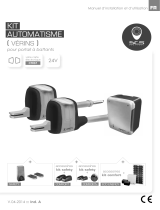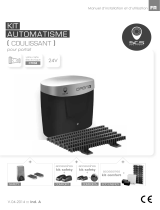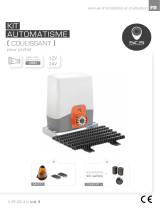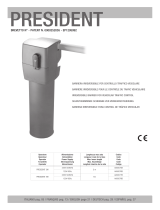Page is loading ...

Manuel d’installation et d’utilisation FR
SERRURE ELECTRIQUE
DE SECURITE
XO 403+TEL
V.09-2014 ::: Ind. A

Installation and operation manual EN
ELECTRIC SAFETY
LOCK
XO 403+TEL
V.09-2014 ::: Ind. A

1
1
3
3
4
4
2
22
2
12 mm 12 mm
A
B
E
C
D
E
F
F
1
Fig/Abb.1
2
Fig/Abb 3
Fig/Abb 2
Fig/Abb 4
4 fixing the keeper
• Fix the keeper using the three screws (E) supplied according to the height
stipulated in the template.
5 electrical connections
• Pass the cables through the correct hole (A).
• Loosen the two screws
1 2 33 34 35
.
• Fix the rst wire between the two small plates.
• Do the same with the second wire (ignore the polarity).
Important:
This type of lock cannot be used on outward-opening gates.
Leave a space of about 9 millimetres between the keeper and the lock
(side F, gure 4).
During a power cut, the key can always be used so there is never any
problem getting back in.
If you want to test your lock before it is installed, the presence of the keeper
must always be simulated by pressing on the memorisation ap (
1 2 33 34 35
,Fig. 1)
to activate the mechanical memory.
1 features
Right opening function electric lock.
Works on 8 – 12 V ~ continuous or alternating current.
Reduced power consumption:
700 mA at 12 V~
500 mA at 8 V~
Voltage: 12-V AC or DC
Important: Terminal wire calibre:
• 1-25 metres: 2 x 6/10 wires,
• over 25 metres: 2 x1.5 mm2 wires (the whole length).
2 installation
The lock is supplied “right” mounted.
3 attachment of the electric lock
• Determine the position of the stirrup and the cylinder hole with the template.
Attention, to plan the space being enough for the passage of the antenna
of the receiver (B)
• Using the four screws supplied, x the carrier to the gate. (C)
• Using the four screws, x the electric lock to the carrier (D).
• To position the support blows up for the antenna around the cylinder, to
come to roll up the cable antenna inside (a single tour is enough). (E)
• Close the electric lock housing back up using the two screws (F).
• To screw the plastic support and to close with the plastic mask to mask saw
them.

-+
6 programming remote controls for the electric lock
J1
J5
J3
P2
EXT CTRL
-/~ +/~
P1 DL1
1 - PROGRAMMING OPENING LOCK
a) In monostable mode (press on the remote control start the opening, the lock is automatically made).
Press 1 time and release the button P1 to program in monostable mode. The light DL1 ignites, simultaneously to press the key wished by
your remote control to realize the opening.
b) In mode bi - stable (a support on the remote control start the opening, a second support allows the lock.
Press on P1 3 time may release, to program in bistable mode.
The led DL1 lights, then press simultaneously on the key wished on your remote control to realize the opening and the lock.
Then, the Led DL1 goes out, the programming is ended. If the programming fails: DL1 ares up again during 10 seconds. You will have
to begin again the operation.
2 - DEPROGRAMMING
Press on P2 once then to release. The led lights, the key is deprogrammed.
3 - COMPLETE DEPROGRAMMING
Press on P2 during 10 seconds, then to release. The led lights, all the keys are deprogrammed.
Don’t throw batteries or out of order products with the household waste (garbage). The dangerous substances that they are likely to include may
harm health or the environment. Make your retailer take back these products or use the selective collect of garbage proposed by your city.
- / ~: Power input, 12Vac or –12Vdc;
+ / ~: Power input, 12Vac or +12Vdc;
J5 Lock coil connector
Ext_ctrl: Input for remote doorphone
/









